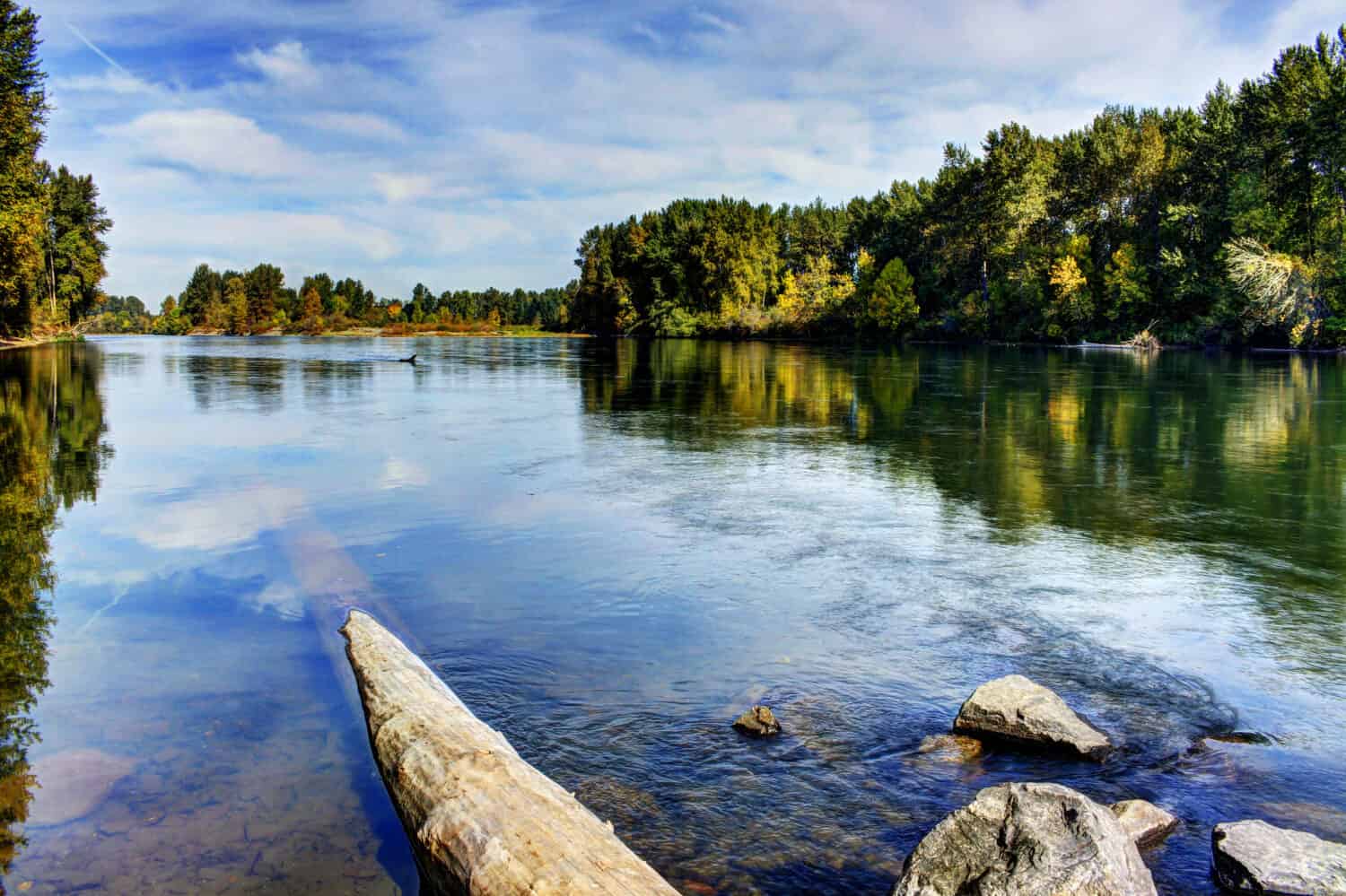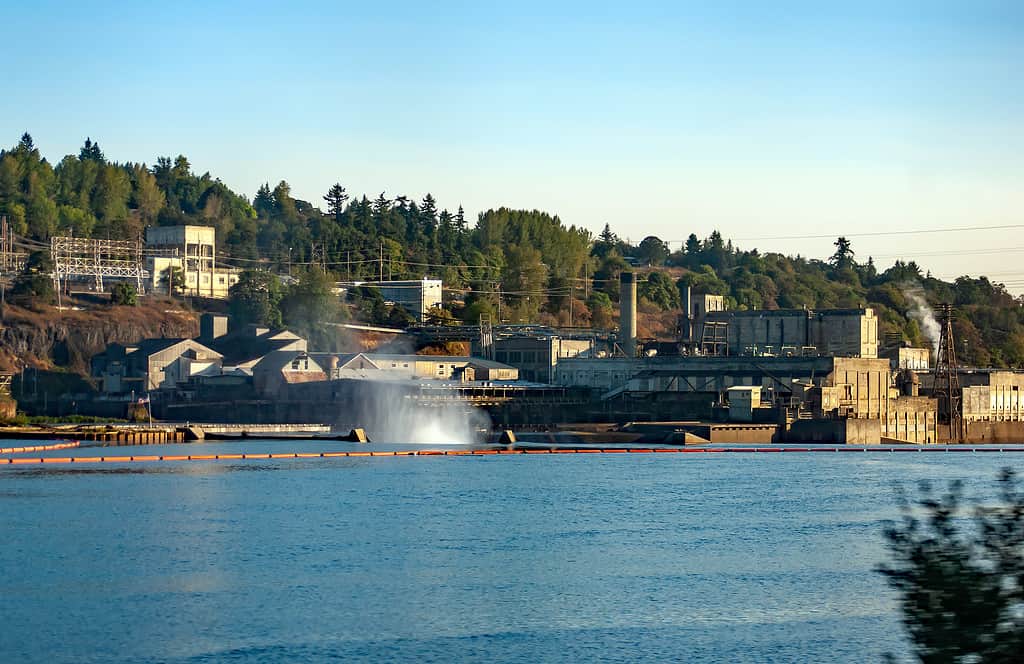Oregon is a Pacific Northwestern state that features a seemingly endless number of water-related adventures. The state has over 1,000 waterfalls (according to the Northwest Waterfall Survey) and a plethora of beautiful lakes, rivers, hot springs, and coastal access sites. It houses Diamond Lake and Crater Lake and observes the Columbia River as it flows into the ocean. Water is life, and Oregon is full of life. Today, we’ll explore the Willamette River.
Of the dozens of rivers in Oregon, this one has some special features, including being one of the largest rivers by volume in the entirety of the United States. Let’s take a look at this beautiful river – and all of the animals and history it cares for.

How Long is the Willamette River?
The Willamette River is approximately 187 miles long. This is a measurement of its main stem. The river actually stretches for nearly 300 miles when you include its middle and coastal forks. It has a maximum depth of 126 feet and a maximum width of around 2,000 feet. The river basin is about 100 miles wide.
About the Willamette River
The Willamette River is the largest watershed in Oregon and actually drains more water per acre than any other river in North America. This is due to the size of the river’s basin. The 100-mile-wide Willamette River Basin takes on much of the precipitation from Oregon’s rainy season and drains it. During the rainy season, the river and its basin drain more water per acre than even the mighty Mississippi! This makes this relatively short river a bit of an anomaly in the watershed world. It’s incredible to imagine a river that is less than 200 miles long draining more water per acre than a river that is over 2,000 miles long.

The Willamette Basin discharges more runoff per acre than any other large river in the United States.
©Heather Elise Endicott/Shutterstock.com
The river begins near Eugene, Oregon. Waldo Lake, one of the clearest lakes in Oregon (and one of the purest lakes in the world), is the main source of its waters. From here, the river flows south to north and eventually reaches the Columbia River near Portland, Oregon. 17 miles of this river flow through Portland, and the city would not exist without it. 70 percent of Oregon’s population lives in the Willamette River Valley, many of them within 20 miles of this important river.
The waters of the Willamette River reach the Pacific Ocean via the Columbia River.
Where is the Willamette River on a Map?
The Willamette River flows through the Willamette Valley in northwestern Oregon. The main stem of the river rests completely in northwestern Oregon and flows through downtown Portland. We’ve included a couple of interactive maps to show you the flow of the river.
The first map shows the location of Waldo Lake. Move the map to the northwest tip of Waldo Lake to see where it drains into the Willamette River. The river is titled “North Fork Middle Fork Willamette River” at this point. Waldo Lake access is only 75 miles from Downtown Eugene, Oregon. It takes an hour and a half in good traffic to get to a series of campgrounds on the southeast side of the lake. You can explore this area or head north to the Waldo Lake Lake Wilderness – closer to the headwaters of the Willamette River.
Next, we’ll look at the Willamette River’s Main Fork, which flows west of Salem. You can see the river winding through Albany and to the east of Stapleton. Follow the river north to Eola and you’ll see it cut east for long enough to touch the central portion of Salem, Oregon.
Finally, let’s look at the Willamette River in Portland and where it terminates at the Columbia River. This is the most urban area of the river and subsequently the most polluted. You can also see where the river forks and becomes the Multnomah Channel. This channel is a 21.5-mile distributary of the Willamette River and begins close to the confluence of the Willamette and Columbia Rivers. The point we have selected to show this is the Historic St. John’s Bridge, which is the last bridge to cross the Willamette before it meets the Columbia. It is also the tallest bridge in Portland.
What Makes the Willamette River Legendary?
The Willamette Valley is the most important agricultural region in Oregon. This is due, in great part, to the Willamette River Basin. This massive basin helps to create and maintain rich and fertile soil. The Willamette River is the lifeblood of northwestern Oregon, and the reason for Portland, Oregon’s existence. The same goes for Salem, a city built in an area the Indigenous tribes called “Chemeketa” or “place of rest”.
Many of the greatest cities in the world rely on the rivers they settled by. Think of Minneapolis, Minnesota, and its proximity to the Mississippi. Consider London and the Thames River or New York and the Hudson River. This is no coincidence. Humans and animals rely on water sources for survival. European settlers often traversed the same routes as the Indigenous Americans that came before them. These routes ran along the banks of rivers and lakes to give tribes access to water, bathing, and fishing.
Riparian areas are also much more fertile than other areas. Most of the fertile soil in North America rests at the confluence of rivers. A great example is the Ohio River Valley, whose fertile soil helped sustain the ancient civilization of Cahokia.
Rivers also encourage trade. Many historical trade routes relied entirely on ship passage, and this is still true – to some extent – today. Rivers promote trade, soil fertility, and life. It is no wonder that the Willamette River is so important to humans and animals alike.

The Willamette River flows through Oregon City, Oregon.
©MrsPeacock/Shutterstock.com
What’s in the Willamette River?
The Willamette River is home to several species of piscifauna and aquatic plants, and these life forms face struggles with human intervention. When we talk about what’s in a river, we have to look at wildlife and pollutants. When we take a closer look at the pollutants in the Willamette River, we actually get to feel some hope. Environmental efforts for the Willamette River have greatly improved the water quality. Now, officials say it’s even safe to swim in the river in Portland. This is great progress for humans and fish – along with many other animal species.
We gauge our ability to swim in rivers and lakes by the number of risks posed by entering the water. These risks include chemical pollutants, bacteria, algae blooms, dangerous debris, and dangerous animals. The past few decades have seen a significant reduction in chemical pollutants being added to the river. It used to be okay to dump oil-based contaminants into the water and it isn’t anymore. There is still some chemical pollution present, but it has greatly improved. As for bacteria, officials say the water is safe and contains a healthy amount of bacteria. There is some debris in the river, but cleanup efforts in Portland, Salem, and in other areas help to keep the waters pretty clean.
Lastly, animals are only dangerous if we interact poorly with them. Oregon has very few toxic or venomous animals and they usually don’t attack unless they feel threatened or cornered.
Is the Willamette River Safe to Swim in?
Yes, the Willamette River is safe to swim in, for the most part. Consider your personal ability to swim along with any external factors. Look for areas of the river that have accessible shores and mellow currents. Unseen dangers like undertow and other powerful currents are important to watch out for. We cannot always see what is on the bottom of the river, so it is good to tread with care and know your limits when taking a swim.
Other Rivers in the Willamette Valley
The Willamette River is not the only impressive river that flows through this portion of Oregon. No other rivers in the area are as long as the Willamette, but they are still quite impressive. Check out the Clackamas River, which is 83 miles long and a major tributary of the Willamette River. It begins at a high cascade volcano called Olallie Butte and flows to its confluence with the Willamette River near Gladstone, Oregon.
The Calapooia River is another important tributary of the Willamette River. Its 80-mile course takes it from its source in the Cascade Mountains (near Tidbits Mountain) all the way to Albany, Oregon where it joins the Willamette.
The Tualatin River is another major tributary of the Willamette River. Are you seeing a theme here? The largest rivers in the Willamette Valley all feed the Willamette River. It is the most important river in northwestern Oregon. The Tualatin begins its course in the Coast Range mountains and flows 83 miles to its mouth at the Willamette River near West Linn, Oregon.
Wildlife

Five different species of snakes live along the Willamette River, including the rubber boa.
©yhelfman/Shutterstock.com
Wildlife abounds in Oregon, especially in the Willamette area. The rich riverways provide homes to several species of animals, including all five types of salmon that live in the western portion of the United States. Five different species of snakes also live along the Willamette River, including the rubber boa and the northern Pacific rattlesnake. Mammals in the area include white-tail deer, raccoons, beavers, minks, and otters.
You can also observe several bird species, including the American robin, spotted towhee, and dark-eyed junco. It’s a great place for bird-watching and wildlife observation. Remember to always keep a safe distance from wildlife when observing it. Touching and interacting with wildlife poses dangers to the wildlife and, sometimes, to you. Wildlife is magical for its wildness, and we should not seek to tame it any more than we have.
The photo featured at the top of this post is © Heather Elise Endicott/Shutterstock.com
Thank you for reading! Have some feedback for us? Contact the AZ Animals editorial team.







